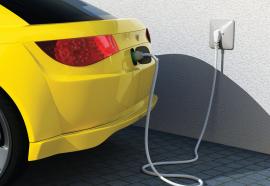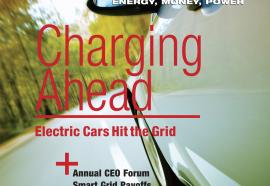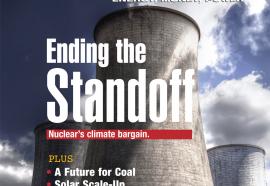PHEV
Electric Vehicles and Gas-Fired Power
A strategic approach to mitigating rate increases and greenhouse gas price risk.
Experience in the Duke Energy Carolinas service territory shows that high penetration rates for electric vehicles, combined with increased natural gas-fired power generation, can result in lower costs to customers and lower risks for utility shareholders—while also reducing total emissions of greenhouse gases. However, these outcomes depend on policy changes that facilitate smart, off-peak vehicle charging, and that allow utilities to capture the benefits of a more environmentally friendly power system.
Electric Avenue
Connecting vehicles to smart systems.
Electric vehicles (EV) are just getting started, with rapid growth ahead. Plug-in hybrids and other EVs could capture 20 percent of the U.S. auto market by 2030. When planning for future infrastructure and technology needs, utilities face difficult questions about how EVs will interact with the utility grid. A comprehensive approach to communicating and integrating vehicle information will allow utilities and drivers to make the most of smart electric transportation.
Grid 2050
Shaping system transformation.
New technologies—and new expectations—require taking a fresh look at the institutions and practices that have provided reliable electricity for the past century. Collective action is needed to define the key attributes of a future grid and then to take the more difficult next step—adapting our processes and institutions to align with that future vision. A thoughtful approach will allow America to capture the potential value that’s offered by sweeping changes in technologies and policies.
DR Distortion
Are subsidies the best way to achieve smart grid goals?
FERC has proposed that wholesale energy markets should subsidize load reductions with full LMP (locational marginal price), without deducting the customers’ retail savings. Such a policy could distort the market, and other solutions might achieve the same objectives more efficiently.
Bringing Customers On Board, part II
The entire utility-consumer relationship must be reengineered.
The business case for advanced metering infrastructure (AMI) can’t be justified alone on operational savings to the utility. But critical assumptions involving process improvements and system efficiencies depend on customer involvement. This sequel to a September 2009 article examines customer engagement strategies and techniques.
Plugging In
Can the grid handle the coming electric vehicle load?
As electric vehicles become commonplace, will the grid be able to handle the extra load? Too many cars plugging in at once might cause disruptions and necessitate costly infrastructure upgrades. Handling the vehicle load in a smart way, however, will ensure a smooth transition to the plug-in future.
Cap and Innovate
An alternative approach to climate regulation.
Low carbon prices might not produce sufficient incentives for firms to innovate and reduce emissions in the long run. But relatively high carbon prices can be politically unacceptable and invite consumer backlash. Where’s the right balance? A PUC chairman offers an alternative approach to managing GHG emissions.
Middle Mile Moxie
Xcel Energy proposes to create America’s first fully functional intelligent grid, with communications and automation systems linking the network from end to end, power plants to meters. Although Xcel still is deploying the system, it’s shown that the early payoff from smart-grid investments won’t necessarily come from automated metering, but from automation in the distribution network—the “middle mile.” As chief architect of the Smart Grid City project in Boulder, Colo., Ray Gogel served on the front lines in the industry’s technology revolution.
3Rs for Power And Demand
Dynamic monitoring and decision systems maximize energy resources.
The operations and planning rules for integrating variable resources aren’t the same across the electric power industry in the United States at present. Opinions are somewhat divided about what these should be, as well as the assessments of potential benefits and costs. In order to support sustainable deployment of variable resources at value, it’s critical to identify major sources of potential problems and to proactively design and implement a systematic framework for managing their unique characteristics as reliably and efficiently as possible.









